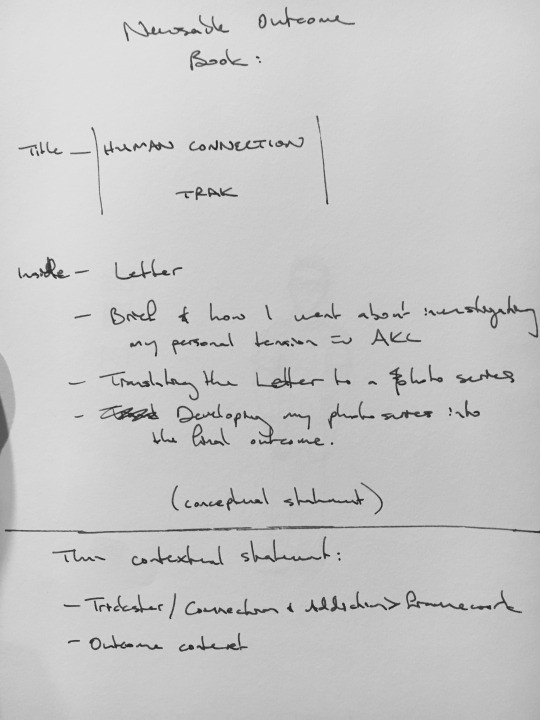Don't wanna be here? Send us removal request.
Link
I am posting all of my work from semester 1, 2017, in a separate blog, accessible by this link.
0 notes
Video
tumblr
I realised I haven't uploaded footage of the electrode experiments so here we go. These were inspired by a series of videos by Daito Manabe who placed electrodes on models to manipulate their facial expressions. This also links to work by Australian performance artist Stelarc, who gave control of electrodes on his body to others over the Internet. I thought that having electrodes as part of a live performance in which audience members were given control of my physical body could be an interesting way of engaging metaphorically with my personal story of being isolated and vulnerable to the impact of other people's actions. I actually really like the idea, however the electrodes were very risky as they were extremely physically taxing on me as the person wearing them. As a solo project it was unsafe to continue without someone who had expert knowledge of the electrodes and the impact they'd have on me, so the idea had to be shelved. It was an interesting and worthwhile experiment though. Experiencing the electronic manipulation really did make me feel quite vulnerable which was apt for my story, and I'm very curious to see how a Marina Abramovic inspired live performance would pan out.
1 note
·
View note
Text
The Photo Shoot
The photo shoot took place on Friday. It was a really interesting experience and I am extremely appreciative of Tanu’s generosity in taking time out to collaborate with me for this project.
After discussing the shoot and sending reference images back and forth we settled on a lighting plan and decided how the images would be framed. I spent the morning of the shoot getting into makeup and met Tanu at the photography suite with my boyfriend, Max, who came along to help out, and for moral support.
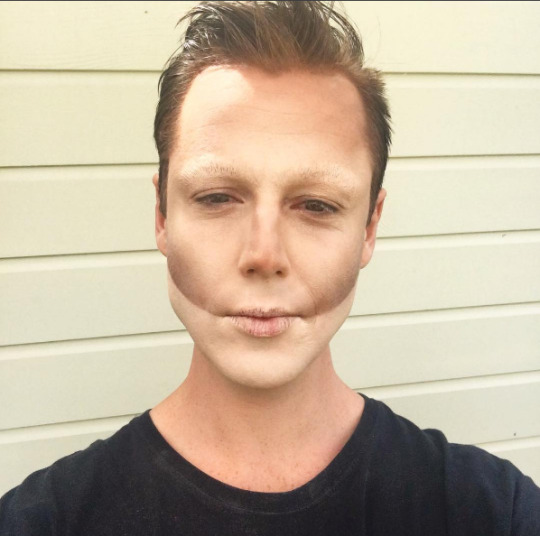
In terms of the images we took, I’m very happy with how they look. They are mostly dark, with side, cut-out lighting framing the body and another light illuminating the face. They still need editing so I won’t post anything about them just yet.
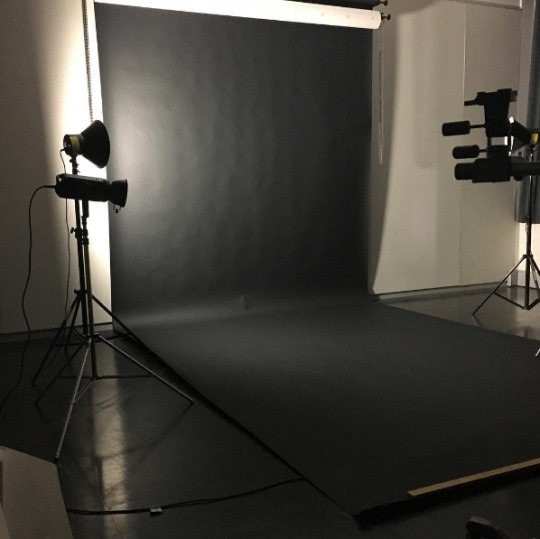
The most interesting aspect of the photoshoot for me was how much the experience of being shot nude like that felt just like each of the times I reinforced my decision to remain in Auckland after moving here. Every time I committed to staying in this city, it felt like I was taking a very big risk: putting my fate in the hands of unknown forces. I had so many experiences of depression and anxiety here, so many experiences of losing friends, losing my house and being deeply lonely, that there soon became a point where staying here felt foolish: “fool me twice...”.
I obviously have a lot of faith in Tanu and a great respect for his work. It’s not putting myself before his camera that made me feel vulnerable, especially given that it was both of us involved in making the images, not him alone, but rather putting my own work, and my own body, in front of a largely unknown audience. Actually generating the images felt like quite a massive step. It felt incredibly shameless, posing in extremely physically exerting poses, nude and in makeup. I was putting my true, authentic, exposed self out there, and that is something that three years in Auckland has sternly conditioned me not to do. It felt at once terrifying and liberating. I felt extremely autonomous and that felt wonderful. I left the shoot with a feeling of pride in this work. I really feel passionate about it and am prepared to reflect on it and defend it as appropriate. I do, however, have an anxiety that, just as my experience of being in Auckland has rendered good results through much torment, responses to my outcome may challenge me, and I will have to be mindful of staying connected to who I am to help deal with that.
1 note
·
View note
Text
Writing the statements
I took my exhibition plan and statement outlines to Anna for feedback to see if I was on the right track.
Exhibition Plan:
I am going to try generate enough images for a series, rather than just a single image, to give my project a stronger visual identity.
I won’t do hanging headphones for the audio. Instead I’m looking at either having an audio player tucked next to the seat, or providing headphones for people to use while streaming the audio online from their own personal devices. This could work well because it would link people to the portfolio page for this work, helping promote me.
Statements:
I was a bit off on what I had allocated to each statement.
Conceptual Statement: describe what the work is.
Contextual Statement: What is sat next to the work.
I should frame the issue as a large city issue, not an Auckland-only issue
I need to better contextualise how the trickster comes into play
Show where this is situated - performance, mixed media, photography, etc
The accompanying booklet should also include a lot of my process work. Anna expressed interest in this. I’m thinking of publishing my statements as Sway website so that they can easily be displayed and accessed online. This could then be sat next to the photography in an iMac. I just need to make sure I can properly embed audio in Sway.
I’m also looking into the work of Shigeyuki Kihara for ideas on how to frame my work. I really love her photography works and I think they sit well alongside my own work. I’ve also been looking at the portraiture of Gottfried Lindauer to better explain the value of working with Tanu for the photoshoot and why I specifically sought him out.
Looking into Kihara brought me to the Metropolitan Museum of New York’s website, where I looked at the way in which they describe the work of artists they exhibit. I’ve adopted a similar approach for my final statements, writing in third person, for an audience with zero understanding of myself, the studio or the work I’ve been doing. It’s going well so far.
0 notes
Text
I’m not the only one
I’ve been looking for some case studies to support the translatability of the framework I’ve developed for this project. After putting out a call for volunteers on Facebook I met with Grace this afternoon and had a really amazing conversation with her about her experience of moving to Auckland, which mirrored my own experience so closely it was eerie.
There are so many similarities I’m going to start off by breaking things down in bullets:
Grace had previously moved to two other cities as well (Wellington and Tokyo) before coming to Auckland. Previous moves had been positive, exciting experiences, but moving to Auckland was extremely difficult.
She found it hard to find a place to live. The the high cost of living and large amount of competition for housing was a major challenge. She ended up living in a series of terrible flatting situations before she managed to eventually make connections - at which point things got better.
She found it extremely difficult to connect with people and had many negative experiences of people not wanting to put effort into forming friendships.
There was a lot of peer pressure to do drugs. There was a feeling of being between extremes where people were either too straight laced and normal and didn’t want to socialise, or people were super hardcore and unhealthy to be around.
She felt lonely and isolated, being stuck between living with a series of bad flatmates or paying a lot to live alone in a crappy, small apartment.
There was a feeling of putting the blame onto herself. She was the one struggling to make connections so it felt like there was something wrong with her.
These feelings manifested in negative views towards her physical body, the need for external validation, changing how she dressed, and physical illness.
By eventually gaining connectedness these problems all resolved. Her dress more authentically represented herself. She was physically healthier and happier.
The key takeaways for me are the following:
This supports Auckland being the problem. Other cities, both in New Zealand and overseas, have been easy and fun for both of us to move to.
The problem started with poor access to adequate housing, and was reinforced by very limited ways to be able to improve housing.
The isolation resulted in feelings of shame and self blame, which in turn manifested in negative views towards the physical body.
Gaining connectedness resolved all the issues.
I love the idea that connection allows us to be shameless. I think it’s a really great was to frame the power of connectedness. When we were discussing dress, Grace mentioned the following:
“I wore things that I didn’t feel comfortable in because I thought it would impress other people.”
I had exactly the same experience, and, like Grace, I feel like I can wear whatever I want without any concern about being shamed now that I’m more connected. It’s interesting that shame can be so closely tethered to housing, dress and the physical body: all things that we live in. Connection allows us to be shameless about how we dress, and also about how we live more broadly. It allows us to be authentic, autonomous and healthy.
Obviously Grace is only one other example, but her experience provides a remarkable degree of validation for my work. I have meetings scheduled this week to check in with other classmates to see how their experiences may align.
1 note
·
View note
Photo
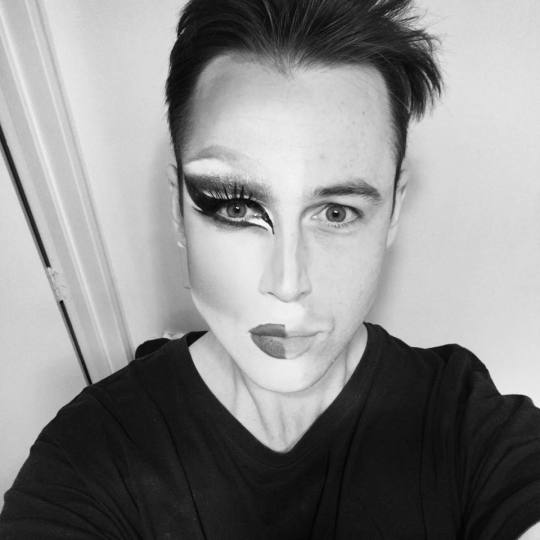
Practicing makeup for the photoshoot.
4 notes
·
View notes
Text
Reflections on outcome: update
I am very happy with the idea for this outcome. I’ve been discussing it with peers and reflecting on it and I think the only amendment I will make at this stage is that the black and white, nude, drag photograph should be the sole outcome. It will still be presented in the same way with the photo on the wall with an accompanying description and a book, but the book will use the letter and illustrations of the clothing series to tell the story behind the picture, rather than have the set presented as three parallel outcomes. The concept behind the picture is robust, and I think that there should be no confusion around the fact that the image is the final outcome. The letter and clothing series will be discussed in my written work and the images of the letter and clothing pictures will be present in the book as example images to support the text.
0 notes
Text
Outcome
In thinking more on the narrative I am telling about being disconnected in Auckland city and feeling shameful, through a journey of development in my dress as I resolve feelings of shame and gain connection, to eventually leaving shame behind (being shameless), I definitely want to do a drag related outcome. I want to do drag as a personal embodiment of trickster, and to execute this I will adopt his approach of exploiting the taboo.
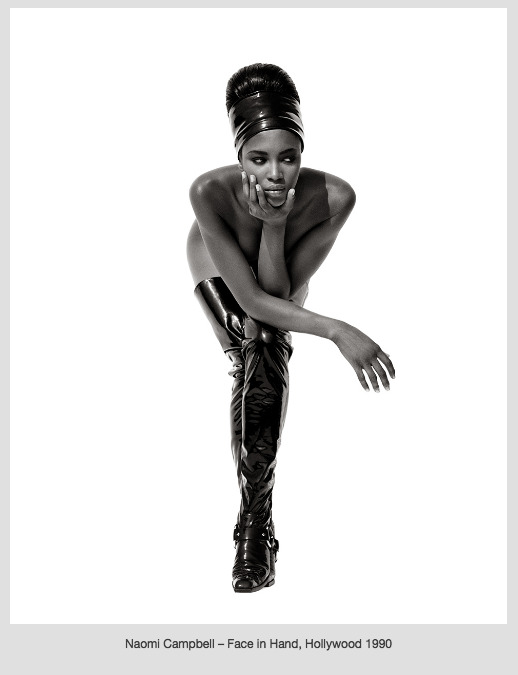
(Image source: http://www.herbritts.com/#/archive/photo/naomi-campbell-face-in-hand-hollywood-1990/)
For my final outcome I want to display a photo of myself in drag in the style of the late photographer Herb Ritts. The photo will be in black and white, with a white background, and I will be wearing only drag makeup and heels. Ritts is known for his black and white portraiture in the style of classical Greek sculpture, which speaks to the context of trickster as Hermes. Ritts’ most famous photographs depict nude supermodels like Naomi Campbell (above) in the late 80’s and early 90’s, during a time in which drag was well established in gay culture and gained mainstream exposure for the first time as the AIDS epidemic opened up gay culture to the wider Western society. The naked aspect of the image takes on trickster’s use of nudity and the perverse to embody shamelessness as a way of revealing shame for the social construct that it is and being able to move beyond it. Drag marries appropriately with both trickster’s shameless approach, and my own personal journey, and I’m very excited about this as an outcome.
I’ll also note here that the photography style inspired by Herb Ritts is appropriate as it can be used to create a sense of intimacy and connection with the subject, unlike many modern forms of portraiture which can easily be interpreted as impersonal images that advertise a product or concept, rather than connect a person intimately with an audience.
The final image will be printed, framed and hung, and presented in studio with a supporting book that contains a reworked transcript of my audio recording in the form of a letter, and the series of clothing photos. I will draw over each of the clothing photos to personalise and develop the images, and to bridge between the handwritten letter at the start of the book and the photographed image at the end of it. In addition to the letter, illustrations of the clothing series and the black and white nude drag photograph, the book will also contain my contextual and conceptual statements, and my blog work. The poster will take the form of a gallery style description of the artwork on the wall, next to the framed image.
I will use Adobe Draw for iOS on my iPad to do the illustrations, and the photograph will be taken in a photography suite at AUT. I’ve approached friend and photographer Tanu Gago to take the picture with me and am waiting to see if he is available.
0 notes
Text
Reflecting on the photo series
I like the photo series, I think it has a strong narrative. It’s interesting in that it goes from colourful but unstable, to dark but put together. I was worried that this would confuse the message but I don’t think it does.
I don’t think this is enough to be an outcome by itself, but I think it could be a component of an outcome.
I think this could be a really good way to bridge between the brief and drag. I’m using clothing to tell a story about being at home, and I think that drag stems organically out of this. It was connection to the drag community that really made me feel empowered.
Clothing and drag:
The development of my dress is important because it shows the changes in my attitude toward my body. As I dressed truer to my personality I felt better about my physical body, my weight, etc. Clothing gave me an ability to shapeshift which was empowering, and I think this speaks appropriately to trickster’s ability to shapeshift, given that my framework for this project comes out of looking at how trickster tackles constructs of shame.
Drag is the next step beyond clothing - it’s the ability to gain control over my very face, to be able to completely shapeshift. There is something in the narrative of having a journey of dress improving as I gain connectedness, and then stepping into a new realm of leaving shame behind (being shameless) as I attain the power to change my face. I need to dwell on this a bit more, but I think that drag could be by own personal embodiment of trickster. It’s like I’ve found a way to have his power. Becoming trickster is what resolves my shame and takes me beyond it.
0 notes
Photo
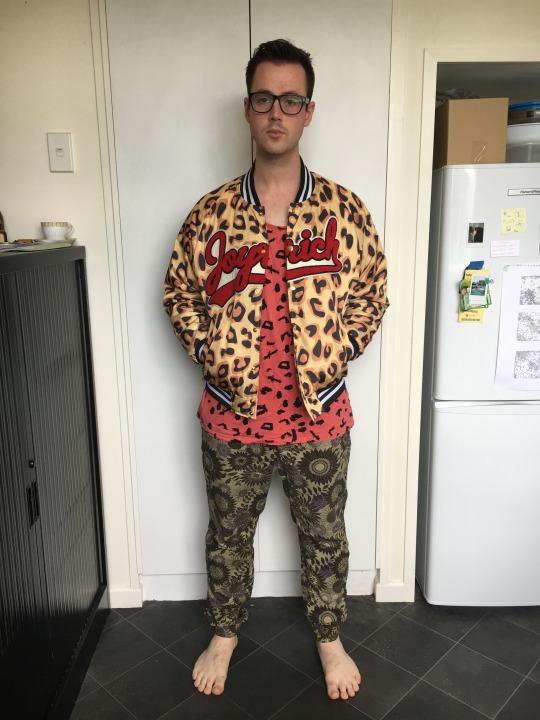
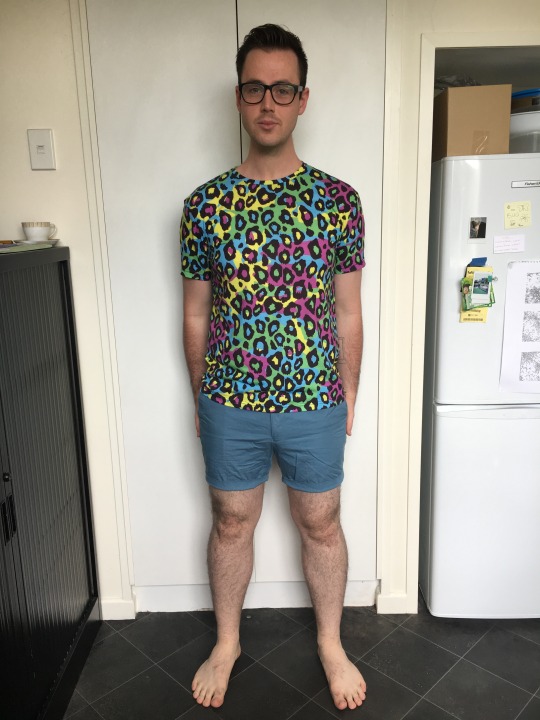
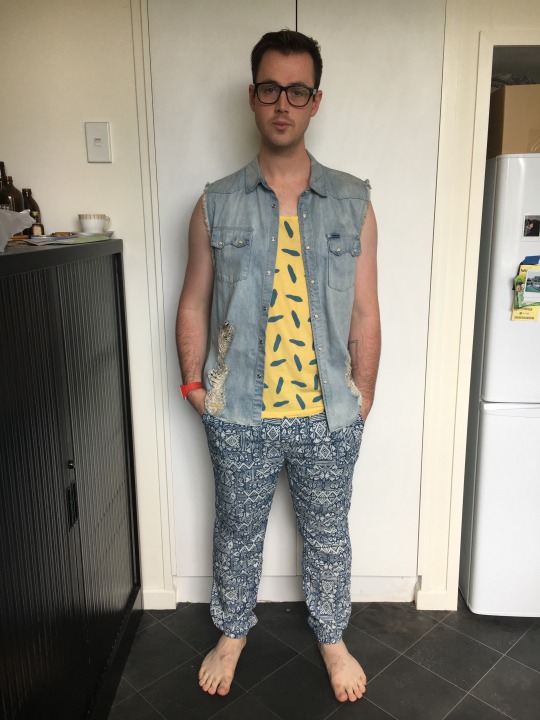
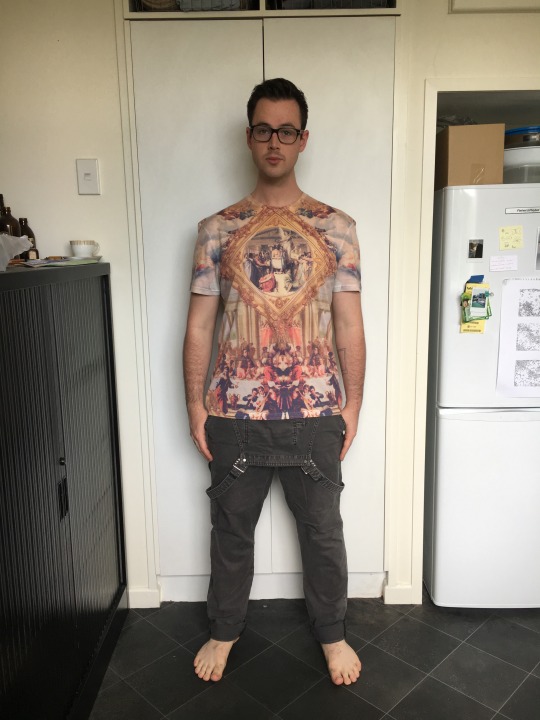
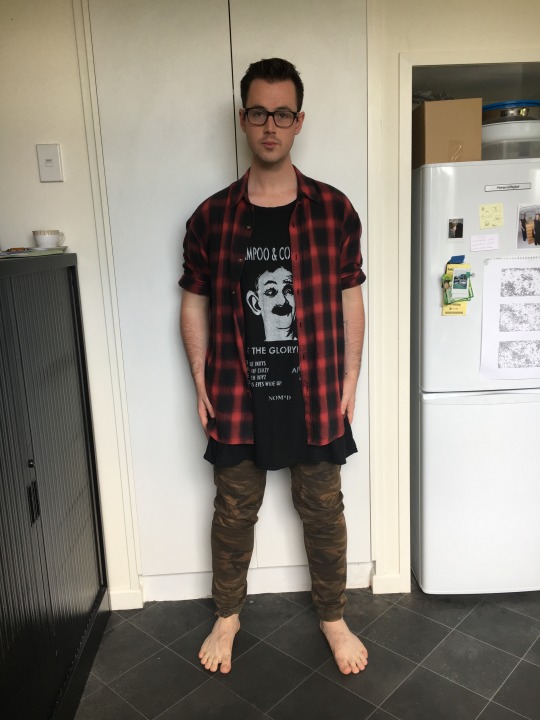

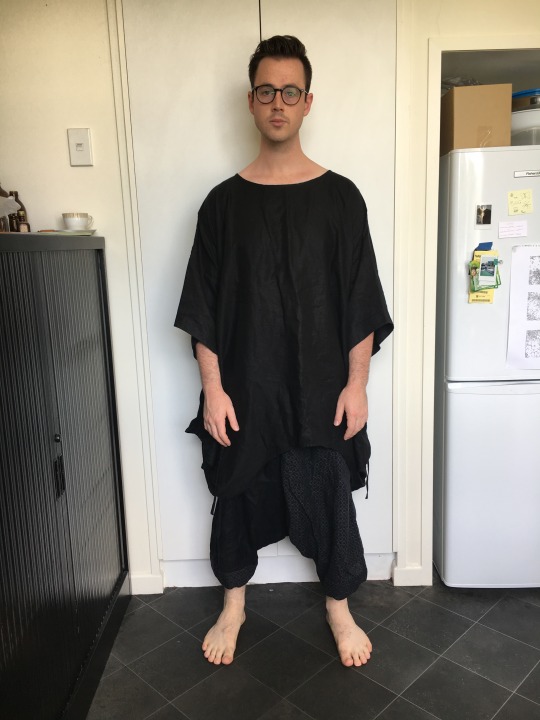
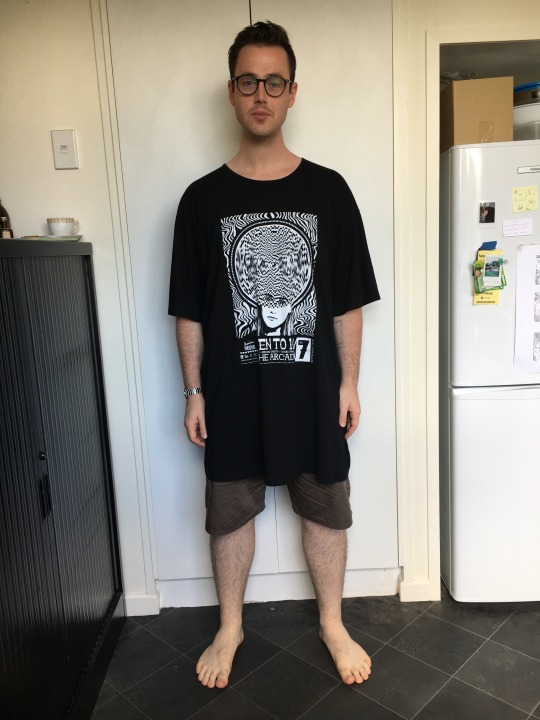
Draft clothing photo series. Info about where photos fit into the narrative is below. Series runs left to right, top to bottom, from disconnection to connection.
01 Disconnected. Unhappy but trying to dress expressively, with the confidence of someone who could pull off wearing anything. Every item of clothing was purchased alone, both in physical stores and online.
02 I wore this outfit to dinner in the summer at a local outdoor pub restaurant with my dad and he refused to go with me (because of my clothing). From that point I really felt like any outfit I wore was an active decision to either conform or rebel, which really threw my perspective out of whack. I felt uncomfortable dressing in conventional clothing because it felt imposed, so I dressed in more unique clothing but I felt a lot of shame associated with doing so.
03 My dress style got more outrageous the more I felt like I had to be totally unique. This represents a real low point for me where my feelings of shame toward my physical body reached a peak and I was self harming.
04 This is an attempt at getting beer. I had connected a bit more with my colleagues at work and had made the decision to return to uni. I still was very lonely though.
05 This is the point where I connected with Max. He helped be be more mindful of my dress and introduced me to new shapes of clothing. The break away from a standard pants/t-shirt silhouette was very transformative and empowering. I felt like I could dress to make my body look better.
06 I really embraced Max’s style and dressed very androgynously. This was fun and empowering, but this was also a point where I could get a bit lost in his style, losing myself a bit.
07 I gained some more of my previous personality, but instead of using colours and patterns to be expressive I used shape. All the clothing was purchased with Max from local stores and we share the clothes between us.
08 My current dress, taking locally designed, androgynous clothing and wearing it in a comfortable, everyday look that is cohesive but also unique. More balanced, more put together, more connected. This is clothing in which I feel present.
3 notes
·
View notes
Text
Reflecting on the update
I sat down with Maggie after having written the last update post. She felt that the brief, context and concept were well developed and made sense, but that when it got to the outcome, it was incongruous with the previously developed work.
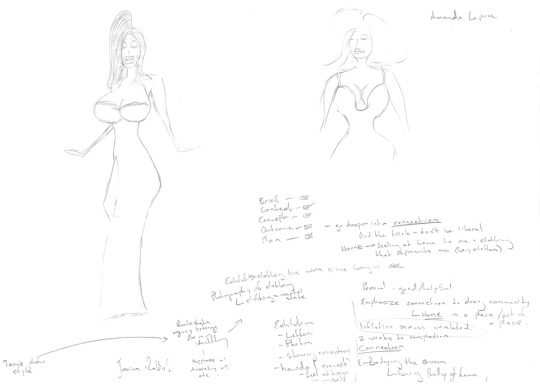
I understand and agree with what she said. The context and concept tell a story out of the brief that defines a focus on mental health and connectedness. I like the fact that the aim is to translate this through a personal outcome and I’ve gotten good feedback from others about the personal aspect, but I can see how the inflating drag costume is too great a leap.
I’m talking about connection and disconnection, with the aim of getting an audience to gain insight through my own personal journey, however a drag outfit that inflates communicates very little to do with disconnection, and says more about pride and confidence. I feel like if the outcome is to contain elements of drag, then the very fact that it is drag needs to be the outcome, rather than what type of drag it is.
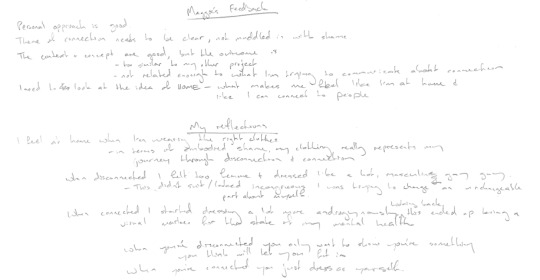
I do think that a focus on clothing is a good direction for the outcome. Clothing for me says a lot about home and feeling at home in myself. The way I dress has changed a lot as I’ve become more connected and I think looking at the clothing I’ve worn is a good way of translating the audio recording I did into something else. When I was disconnected I dressed in a way that projected a confident, flamboyant character who wasn’t really me, but rather the person I wanted to be. I used clothing as a prosthesis to try present a different physical form, but the internal shame I felt and the frustrations towards my body weight in particular meant that I wasn’t really dressing appropriately. As I got more connected, the internal tensions were dealt with and I began to really represent myself in what I wore, being present in my interactions with society, rather than hiding behind a mask of clothing.
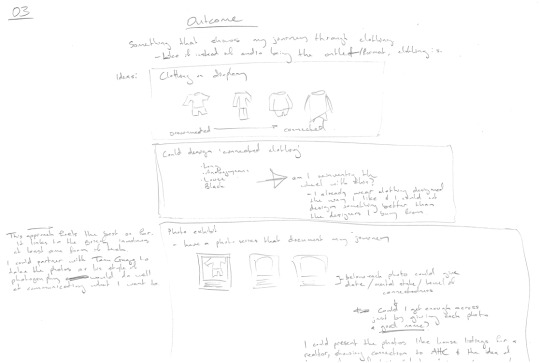
The plan moving forward is to take a series of photographs of my clothing that tells this story. I am unsure whether this will be enough for a final outcome, which is frustrating, but at this point I’m just going to go for it (quickly), reflect on it and see what happens.
0 notes
Text
Update
The brief: explore Auckland’s housing “crisis” (AHC) from the perspective of young Aucklanders and create an outcome that is some form of online publication or public exhibition.
ie: “Collectively explore ways to engage young Aucklanders in an informed and meaningful conversation about housing issues using creative technologies tools and approaches (Jackson & Allen, 2016).”
Context: The AHC presents logistical difficulties that inhibit social connection in Auckland city. I’ve looked at research that frames the mental health impact of being disconnected in society, creating a framework that shows how social disconnection negatively impacts mental health and can manifest in negative attitudes toward an individual’s physical body (i.e. embodied shame).
Concept: I am applying this framework to myself, creating a personal outcome that looks at the embodied shame I experienced around my gender identity that arose when I moved to Auckland and spent years being lonely, unsupported and disconnected. A key part of the outcome is the fact that the same framework could be applied to other individuals to create an equally personalised outcome.
Outcome: My outcome is a drag look with a costume that inflates in response to audience engagement. The look provides a commentary about my own journey through disconnection and connection, wherein the naked male form embodying shame pertaining to gender identity is shielded by a drag persona developed through connection with the drag community. The outfit will be designed to inflate to the point of bursting, acting as a metaphor for my story of personal development as audience engagement (connection) eventually allows the body underneath to be celebrated.
Plan: Plan the look (concept drawings) and construct it. I will investigate electric fans and air canisters as activations. The audience sensor may be tech or manual and incorporated as part of the performance. The final studio presentation will have this project alongside my other studio project (also a drag outcome), with the dress on a mannequin, video of the dress’ performance and a bound magazine containing all my concept/context work.
References:
Jackson, A. & Allen, M. (2016). Newsable Lab Outline. [Document]. Retrieved 15, August, 2016 from http://www.autonline.ac.nz.
0 notes
Text
Developing the opposite of body hate concept:
Looking at Amanda Lepore has got me thinking about the nature of drag, how extreme it is and how drag, by definition, answers the issues I’m trying to tackle around embodied shame. I think that taking an approach inspired by her could be very interesting.
Amanda Lepore is a famous transexual artist and performer from New York. She gained fame as a club kid in the 1990’s. She is commonly known for doing looks inspired by the 1988 cartoon film character Jessica Rabbit, from Who Framed Roger Rabbit.
““Amanda has no interest in being a girl,” photographer David LaChapelle—one of her longtime mentors—once told me. “She wants to be a drawing of a girl, a cartoon like Jessica Rabbit. When I told her that silicone is dangerous, she said, ‘I don’t care, as long as I look beautiful in the coffin’. There’s something kind of profound in that, that she’s creating this moment of beauty for herself and is willing to make the ultimate sacrifice.”” (Taken from Lepore’s bio page).
If I took a character like Jessica Rabbit, who is already a caricature, and applied another layer of caricature with drag, I could yield some very interesting results. If I look to the Australian drag performer Dallas Dellaforce, and her 2013 performance as part of the show Briefs, there are some really cool examples of how the caricature can be taken past female drag - to male. This is done in a way that uses the body in a nude and phallic way, as a trickster would.
youtube
I think it could be very interesting to have a technologically activated look that exaggerates body proportions to the point of breaking - such as inflating breasts and ass that get so large they eventually burst. It would be very entertaining to see a performance where the audience is brought on board to encourage the drag performer to go bigger and bigger, then when the bodily form reaches breaking point the shameful body underneath would be revealed and this could rear up as an ugly beast.
References:
Dellaforce, D. (2013). BRIEFS: Dallas Dellaforce Performing @ Dragged Up. [Video]. Retrieved 26 September 2015 from https://www.youtube.com/watch?v=01LkjK1l1uw.
Lepore, A. (n.d.). Amanda Lepore Bio. [Webpage]. Retrieved 26 September 2015 from http://amandalepore.net/bio.
0 notes
Text
Check in with Marcel:
I have confirmed with both Anna and Marcel that developing my ideas towards a performance/drag outcome is appropriate.
The key focus is embodied shame. Connection is a key element in communicating the functionalities of embodied shame. Technology will be implemented in a way that bridges individual, embodied shame with a participating audience.
Understanding the theoretical framework through opposites:
Marcel reminded me to look at the opposites of shame, like pride, dignity and respect, and how that relates to my theoretical model. I think this is very helpful feedback and I think it provides a way for the relationship between shame and connection to be exemplified.
The model I am using takes Lewis Hyde’s model of society, the body and the psyche and links it to Johann Hari’s work on connection and addiction. In the case of shame in the psyche, Hyde’s model shows this coming from societal pressures. These social pressures create feelings of shame in the psyche which then manifest in attitudes towards the physical body (i.e. ‘I feel ashamed of being overweight because people won’t date me’).
Hari’s model takes societal disconnection and links it to addictive behaviours. In this case an example may be: ‘People won’t date me so I’ll start smoking to lose weight and deal with the feelings of rejection’.
There is a clear and helpful crossover here, where we see disconnection from society (i.e. disconnection + society) result in shame in the psyche which manifests in negative attitudes to aspects of the body, the response to which are addictive behaviours.
If we flip this and take a person who is supported and feels at home in their society (i.e. connection + society), this results in feelings of pride and self respect which in turn make people feel positively to their body (i.e. weight, skin colour, sex, etc) and engage in healthy behaviours.
Understanding drag:
Marcel also advised me to deconstruct the concept of drag and relate it to the concept of home or belonging.
Drag is a performative embodiment of gender through caricature. This differentiates drag from other forms of cross dressing like gender illusion or transvestism, as the point of drag is not to realistically portray a gender (or aspects thereof), but rather to entertain people by portraying an exaggerated, theatrical version of gender that can act as a commentary on gender issues.
This definition of drag indicates that if I am to use it as the format for my outcome, the type of shame I explore should pertain to gender. This could relate to my framework in the following ways:
Societal context: gendered expectations of men.
Disconnection: Disengagement with femme guys. Prejudice when dating, family and peer bullying. Broader social commentaries and perceived expectations.
Psyche: shame pertaining to femme gender identity
Body: disliking bodyweight. Feeling that society would have a place for you if you had a ‘perfect’ masculine body. Self harm.
Addiction: drug use, smoking, unhealthy relationships toward food and exercise.
And also in opposite:
Societal context: gendered expectations of men.
Connection: drag provides a connection with gay culture and community.
Psyche: pride pertaining to ability to engage with and inspire community.
Body: proud of ability to transform and perform. Control over body.
Addiction: Not present.
We can see in the aforementioned breakdown that drag provides a means of connection with the gay community. It’s a channel through which individuals can meet and engage meaningfully with one another, creating a sense of home and belonging. As demonstrated in the 1990 documentary film Paris is Burning, drag has a history rooted in family structures, where new queens are adopted into a house and mentored by their drag-family to develop both as performers and as individuals.
I think the key reflections on this should be around how technology could best be implemented to communicate this. I think through looking at opposites there could be something interesting in taking the extremes of disconnection and the subsequent body-hate and applying this in reverse to drag as an embodiment of total control over the body. This could be a drag look that takes something as extreme as self harm and reinterprets it as self care, or self improvement. Perhaps this would be a male drag look in which the (perceived) perfectly desirable physical form is constructed. Or an extreme drag look on the scale of Amanda Lepore, who looks like a human, Jessica Rabbit sex doll. I think looking back at Hyde’s work and getting examples of how the trickster overcomes shame could be useful.
I have considered the approach of articulating drag as a metaphor for home, looking at artists like Lucy and Jorge Orta who have designed collections of “Refuge Wear” and “Body Architecture” (1992–1998) in which architecture is given a wearable form, however while I love their work and like the approach, I feel like it is too literal a development of my concept. I think with the robust framework I have I can take greater risks, as suggested by Maggie. If I do loop back to this idea at all I think the best execution would come out of looking at Orta and Orta’s “Nexus Architecture” (1994-2002), in which people’s suits connect to one another to create architectural structures.
References:
Livingston, J. (1990). Paris is Burning. [Documentary film]. Off White Productions. New York.
Orta, L. & Orta, J. (n.d.). Studio Orta. [Website]. Retrieved 25 September 2015 from http://www.studio-orta.com/en.
0 notes
Text
Maggie's feedback
I was advised to go to Maggie for feedback during my formative assessment critique, so I sat down with her and went through my project, covering the same stuff as in my formative presentation.
Maggie said that the social media platform thing was basically reinventing the wheel: it was too obvious and safe, and it’s not something people would really use as there are heaps of storytelling websites out there. If it was created to supplement some sort of localised educational initiative it may have a footing, but I feel like this steps away from where I want to go.
She liked the contextual work I’d done and the focus on embodying shame/changeable social place vs unchangeable bodily tether/what's within is without. She encouraged me to be very clear about my message and, specifically with shame, she talked about being able to embody ‘how awful it is’. She referred me to reading Arnold Mindell’s work, particularly Sitting in the Fire. He was a student of Carl Jung’s and has been very influential in new age psychology.
Maggie strongly encouraged me to take more risks and was quite interested in my drag cellphone dress project for my other studio project. She said that there was a lot in that project that fitted with the conceptual development for my Newsable project, particularly the elements of physical embodiment and something in the space of mobile phones and communication/connectedness. She inquired about links between the two studio projects and we discussed this, with me saying that I was very mindful of the fact that one of the conditions of my being able to do two studios concurrently was that they would be distinctly different projects. As we talked about this it became clear that my efforts to do something different to my other studio were preventing me from trusting myself enough to take risks because I was afraid of taking this to a similarly weird and wonderful place. Obviously she did not have a full understanding of the conditions of my double studio arrangement, but she did say that having two complementary projects was worth exploring.
I really agree with this, and I think that there is a way in which I can have two complementary projects with clear, separate conceptual rationales. I believe there is a way in which the projects, when next to one another, could combine to be greater than the sum of their parts.
Moving forward I will look into Mindell’s work and do blog work that clearly articulates my concept in the form of a draft conceptual statement. As part of this I will show clear links to how this fits into the brief. Then I will explore how this concept can be developed into an outcome and talk to Anna and Marcel about the appropriateness of doing something related to my other project.
0 notes
Text
Formative assessment feedback
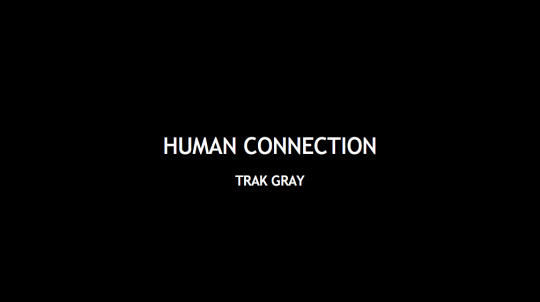
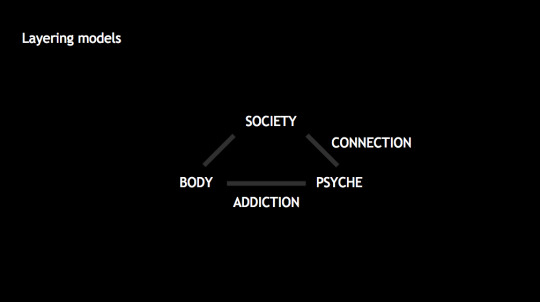
For my formative assessment I mostly talked about the conceptual backing and research for my project, with the outcome still being very much in WIP state. I discussed the framework I was developing from looking at Johann Hari’s addiction and connection work and Lewis Hyde’s work on embodying shame. The outcome I presented was an audio component, with space for additional components relating to Hyde’s society and body.
The conceptual framework was well received and I think the deep, personal elements were appropriate. The focus on connection was seen as a strong element. In regard to the outcome, the tri-faceted structure came across as overworked and complicated. I was advised to focus on the audio component and develop that into something along the lines of an audio based, digital storytelling platform that explored connectedness in Auckland as a changing city and helped make people feel more connected.
My reflection on this is that I agree that the framework is strong but it needs to be more cleanly articulated. I think if I really focus on how shame is embodied as my juicy, ‘this is what it's about’ component it will be successful. I know I presented this as a project about connection, but I think connection is the solution to the problem, and embodiment of shame is the problem (which is far more interesting to explore).
The outcome certainly does need to be a lot more clean and concise. I want to like the idea of a social media site for guided, audio storytelling, but it just feels like a tool that nobody is actually going to end up using, which worries me. At this stage the framework is good but needs to be clearer so I'll do a bit more supporting research and the outcome needs to be more inspired.
0 notes
